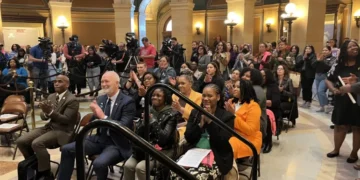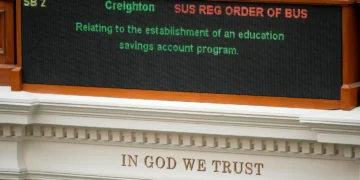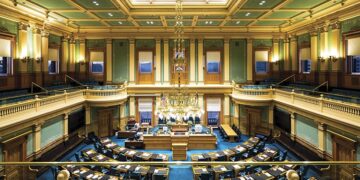Jan 17, 2025 Story by: Editor
On January 10, Governor Gavin Newsom is set to present the 2026 state budget to the Legislature. Ahead of this, on January 6, he unveiled key highlights during the presentation of the North San Joaquin Valley’s regional economic plan. This initiative is part of California’s broader Jobs First Economic Blueprint, designed to spur local and statewide economic growth.
The proposed $322.2 billion budget, which includes $228.9 billion in general fund allocations, tackles a $2 billion shortfall as mandated by state law. The Legislative Analyst’s Office (LAO) reports that while $16.5 billion in extra revenue—bolstered by a strong economy, stock market gains, and increased tax receipts—provides some leeway, structural challenges persist. Spending is projected to grow annually by 5.8%, outpacing the anticipated 4% revenue increase, with deficits potentially reaching $30 billion by the 2028-29 fiscal year if adjustments are not made.
To stabilize finances, Newsom plans to save $1.2 billion over two years by eliminating 6,500 state jobs and cutting $3.5 billion through operational efficiencies such as reducing travel and modernizing IT systems. He emphasized that essential programs will remain unaffected. Temporary revenue gains, including $7 billion from stock market-linked income taxes, provide short-term relief but lack sustainability, making the $17 billion rainy-day fund critical for future financial challenges.
The 2026 budget integrates strategies discussed during a December 2 special legislative session. This session focused on preparing for potential conflicts with the Trump administration and safeguarding state programs from federal disruptions or funding cuts.
During the session, lawmakers introduced SBX-1, authored by Senator Scott Wiener (D-San Francisco), allocating $25 million to the California Department of Justice to defend state policies against federal challenges. This funding will support Attorney General Rob Bonta’s office in lawsuits related to reproductive rights, zero-emission vehicle standards, and the Deferred Action for Childhood Arrivals (DACA) program. An additional $10 million will assist local governments in defending their initiatives.
Investments in Education
The proposed budget continues significant investments in education, healthcare, housing, and economic growth. Proposition 98 funding for K-12 schools and community colleges will rise by $1.5 billion to $116.8 billion, bringing per-pupil spending to a record $23,723. Of this amount, $2.8 billion is earmarked for new programs, reflecting growth forecasts and a 2.46% cost-of-living adjustment. Key initiatives include Universal Transitional Kindergarten, expanded after-school and summer programs, and Universal School Meals, aimed at improving educational outcomes.
Despite increased funding, disparities remain, particularly for Black students who experience suspension rates nearly three times higher than their peers and lower graduation rates. Additional funding could address these inequities through teacher training, mental health services, and restorative justice programs. Investments in literacy programs, such as dyslexia screenings and intensive tutoring, will also be prioritized.
California’s higher education system will benefit from increased funding to enhance affordability and access. The budget is expected to support financial aid expansion, enrollment growth for underserved groups, and infrastructure improvements while aligning educational programs with workforce demands.
Addressing the Housing Crisis
Black Californians, who make up nearly 6% of the state’s population, represent approximately 50% of its unsheltered homeless population. With the state’s homeless population exceeding 180,000 as of 2024—a 31% increase since 2007—housing affordability remains a pressing issue. The average monthly rent for a two-bedroom apartment statewide is $2,225, contributing to housing instability. The budget is expected to fund affordable housing projects, homelessness prevention programs, and emergency rental assistance, though long-term solutions such as expanded funding for affordable housing developments and tenant protections are essential.
Healthcare Initiatives
Medi-Cal, serving over 14 million Californians, remains a critical focus. Federal funds cover 64.4% of Medi-Cal’s budget, making potential policy changes under the Trump administration a significant concern. Reserves have historically been used to stabilize the program during uncertain times. Budget proposals include expanding mental health services, addressing maternal and infant health disparities in Black communities, and increasing funding for community clinics.
Environmental and Economic Challenges
The budget prioritizes environmental justice, focusing on air quality improvements and providing safe drinking water in underserved areas. Public transportation improvements aim to boost accessibility and economic mobility for Black and low-income communities.
Black Californians face economic recovery challenges, with an unemployment rate of 6.7%, compared to 3.4% for White and Asian individuals and 5.9% for Hispanic or Latino individuals. Workforce development programs, including apprenticeships and small business grants, will be crucial in addressing these disparities.
The Role of the CLBC
The California Legislative Black Caucus (CLBC) is expected to play an active role in budget negotiations, advocating for equitable distribution of resources. The CLBC’s priorities include allocating Proposition 98 funds to address educational disparities, increasing funding for affordable housing, and targeting healthcare initiatives for underserved communities.
Key budget milestones include the updated proposal on May 14, reflecting revenue adjustments, and the final budget deadline on June 15.
Governor Newsom’s 2026 budget seeks to address systemic inequities while maintaining fiscal responsibility. The involvement of stakeholders, including the CLBC, will be instrumental in shaping solutions for critical issues affecting Black Californians. Source: Sacob Observer
















